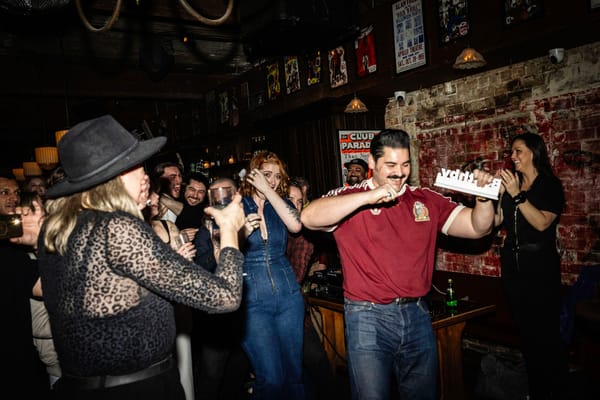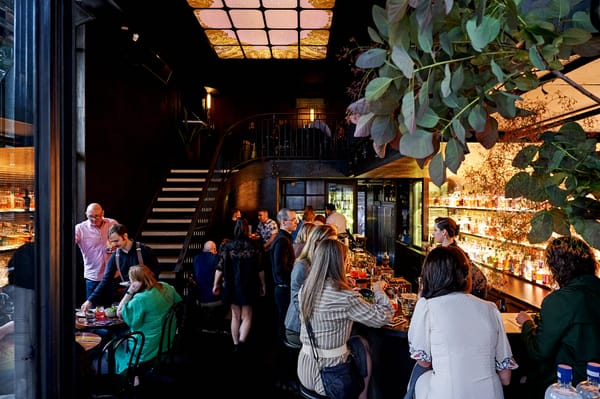Product Dive: a look at each bottling from Old Young’s Distillery
A tasting through each of the distillery's offerings.

WITH SUPPORT FROM OLD YOUNG’S
Welcome to the Boothby Product Dive, an in-depth look at bottles of note. Whilst Old Young’s sponsors this story, the editorial is Boothby’s own.
The Australian craft spirits industry is in an interesting place. By some measures, it’s in a great place: the Australian Distillers Association, the peak body representing the interests of Australian distillers, celebrated their 20th anniversary at a conference in Brisbane earlier this week, and the country is now home to more than 600 distilleries.
But this comes at a time when the cost of living is making spirits less affordable for many people, and — as the ADA president Holly Klintworth said last week — the twice a year increases in the spirits excise tax is contributing to inflation.
Making quality spirit is more important than it has ever been. And having a unique point of difference is essential — when there are more than 900 Australian gins on the market, it can be hard to get noticed.
Old Young’s is a distillery that has been getting noticed and winning awards for the quality of their product since launching back in 2016. The WA distillery — as founder James Young notes in the discussion below — might play in both the vodka and gin space, but they’ve marked out some distinct territory for themselves in doing so.
They do just those two categories — and they do them well — at Old Young’s (although we hear they might have a brandy in the works, too). The distillery makes four vodkas, one of which is — and I think I can justify this — the world’s best pavlova vodka. (Yeah I know: flavoured pavlova vodka. Try it. It’s very good.) They also make four award-winning gins, including a 100 percent juniper navy-strength bottling.
The brand is well represented on the back bars of WA, and since 2023 they’ve been making efforts to get into more bars on the east coast of Australia. The brand also opened a crowdfunding round last year, raising some $2.75 million.
(Oh, and last year the brand’s founder, James Young, shared his story — he started Old Young’s with just $30,000 — on the Drinks At Work podcast, which was probably their 2023 highlight, let’s be honest.)
I spoke to James again recently, to ask him about each of his distillery’s releases and how he thinks about them. Below, you’ll find notes on each bottling with Old Young’s describes each bottle, my tasting notes, and a chat between myself and James for more information.
Let’s dive into it.
The context
Old Young’s is a WA-based distillery that makes gin and vodka, and has done a good job of it since beginning in 2016. That’s what the awards shows think, too: the distillery won the title of champion distillery of the year at the Australian Distilled Spirits Awards in Melbourne in 2017, which is no small feat. That award was made even more impressive in 2018 when OldYoung’s was named champion distillery of the year again second time.
They’ve picked up a slew of gold medals along the way, and last year Old Young’s was named brand innovator of the year and craft producer of the year at the Icons Of Gin awards in London.
Last year, Old Young’s also completed a crowdfunding campaign that saw them
How is Old Young’s made?
Old Young’s is made at their distillery in the Swan Valley, which is — as the Swan Valley website helpfully points out — just 25 minutes from Perth. It’s an old winemaking region — the first vines were planted all the way back in 1829 — and its proximity to the city proper makes it an easy escape for a distillery tour.
Tim Kempton is Old Young’s head distiller and is responsible for the day to day operations, and they’ve got a team of three distillers — with James Young popping in on occasions — distilling five days a week.
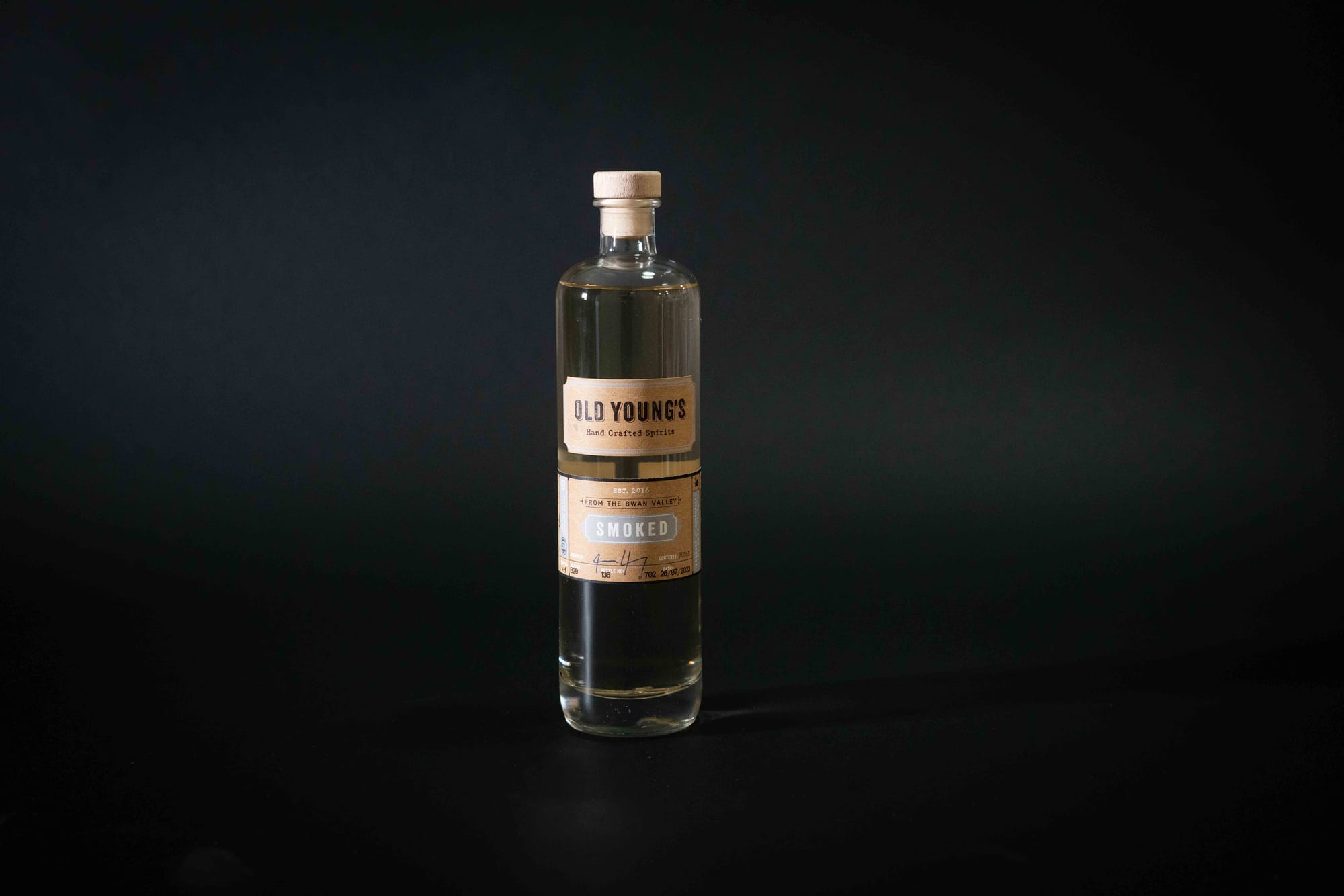
Old Young’s Smoked Vodka
What they say: Think American BBQ meets peated whisky meets campfire. Hickory, Cherrywood, peat and Eucalyptus are smoked and infused into this vodka to create a unique and full flavoured smoky vodka.
What we say: rounded aromas of smoke on the nose, rich smoke on the palate — a touch of grilled meats. There’s a hint of citrus, and a little white pepper framing the long finish.
Sam Bygrave: Why a smoked vodka?
James Young: I saw it as the one for the whiskey drinker. I always got into distilling to make gin, but the mothballed distillery that I took over had made some vodka, some flavoured vodkas, and there were enough people walking in the door asking for it. But my thing is that flavour vodkas are usually thought bubbles. People make a black truffle vodka and then people buy it on wine tours because they’re six vineyards and a distillery deep and they buy it and then it sits on the shelf for the next two years until it’s two o ‘clock in the morning, and you’ve drunk everything in your house and then you go, what the fuck do I drink with black truffle vodka? And then you realise like, I don’t give a shit. It’s two o ‘clock in the morning. You put Fanta in it. But no one ever bothers to think about what’s great with a pineapple vodka or they’re just complete, horrible, sugary shit.
So I tried to make vodkas that I thought that would have an easy, obvious mixer, something you can buy from a supermarket or a service station, or make interesting cocktails.
So Smoked is my vodka for whiskey drinkers. Its barbecue meets whiskey meets campfire. My theory was, that there are a lot of cocktails that’ll call for a little bit of like Ardbeg or a little bit of Laphroaig or something where it’s like, hey, we want to get that smoky flavour as well. Let’s create something with a really interesting smoky flavour. It goes great with apple juice. It goes great with ginger beer because basically it’s a smoky Mule. So instead of a Mule just being vodka being the alcohol delivery device, it’s actually adding something to it. It makes a shit hot Bloody Mary.
The woods that we’ve used are hickory and cherry wood, and then there’s a tiny bit of eucalyptus. The eucalyptus is the campfire and like the eucalyptus, you can’t find it, but if it’s not there, you’d notice. It’s just there sitting in the background. Also, I wanted it to be multi-dimensional. I wanted this to have layers of flavour, so it wasn’t just a one trick pony.
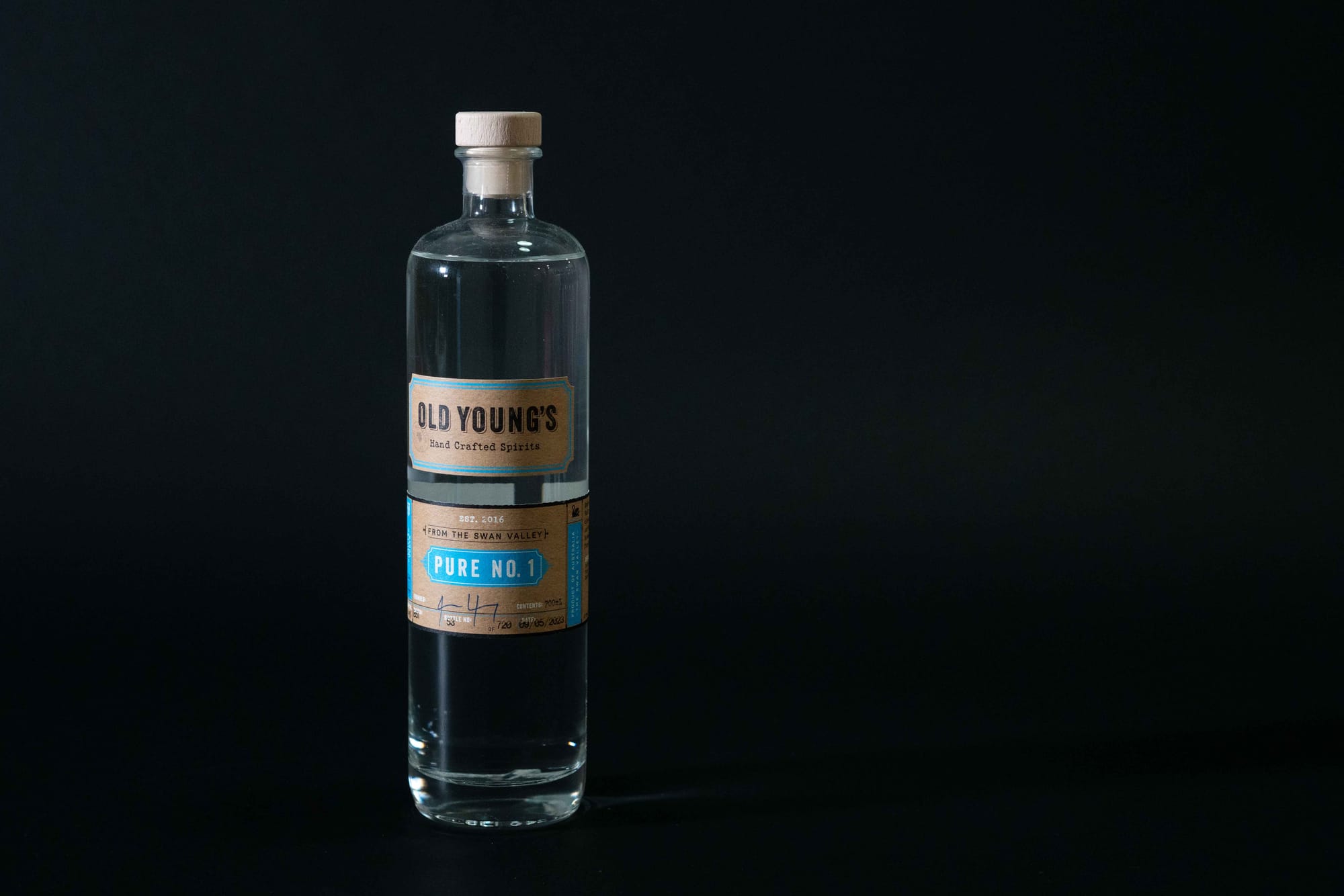
Old Young’s Pure No. 1 Vodka
What they say: Made from Swan Valley grapes and Australian sugar-cane, this vodka is incredibly smooth across the tip of the tongue with a hint of warmth but definitely no burn on the back palate. The grape base gives this a viscous mouthfeel.
What we say: Clean nose with faint floral notes, perhaps a hint of citrus; it’s a well made vodka with a creamy mouthfeel, and some vanilla notes to the long, pleasant finish.
Let’s talk about the Pure No. 1 Vodka.
Swan Valley, second oldest wine region in Australia, right? And again, it was like, I don’t want to make what everybody else makes. And given the fact that like 90 percent of vodka, as we just discussed, is, GNS and and water it was like, well, what can we do to make this vodka unique?
Well, we’re in the Swan Valley. Let’s make a hundred percent grape vodka.
I tried that and, whether it was me or the quality of the distiller or the quality of the product, but it was too feisty. I mean, there’s a reason that brandy goes in a barrel for longer than whiskey. So the idea of the vodka being a hundred percent great was lovely in theory, but terrible in practice.
Yeah.
So if I can’t do 100 percent grape, how can I still incorporate it? And there’s a winemaker’s trick, right? I did a blend. Pure No. 1 is actually Pure No. 1, because there was a Pure No. 1 and a Pure No. 2. And so Pure No. 1, I made with cane and grape, and Pure No. 2, I made with wheat and grape.
Okay.
I was thinking wheat because West Australia [has] great big fields of wheat. But it tastes like every other vodka on the planet. It wasn’t different enough. And the cane and grape, the cane had the smoothness and the grape, by the time you’re down to 10 percent [in the blend] it had warmth, but not kick. It didn’t have burn, but it had warmth and it gives mouthfeel. So you’ve got this best of both worlds, where you got the smoothness from the cane and some warmth and some mouthfeel from the grape. And so that’s what I went with.
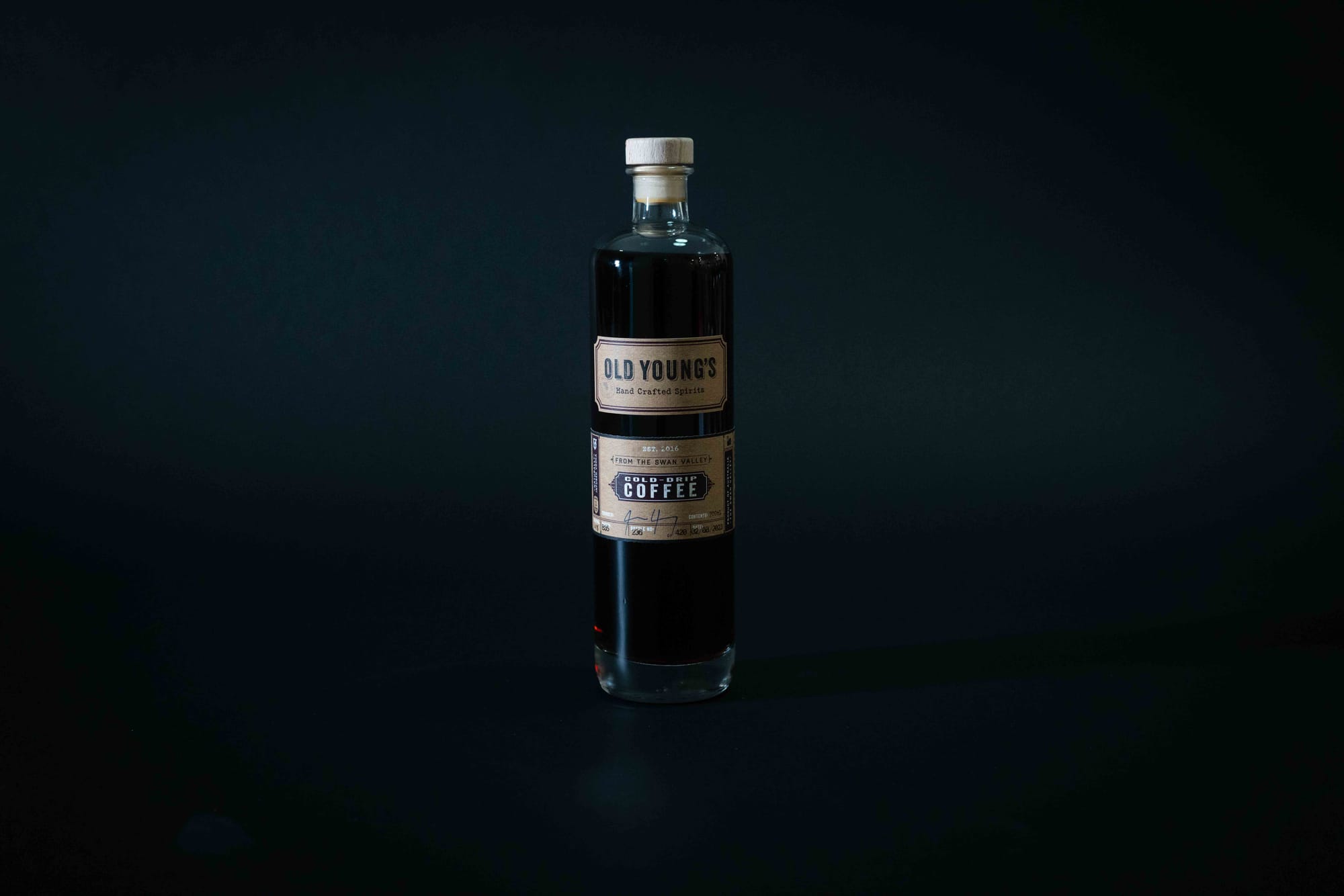
Old Young’s Cold Drip Coffee Vodka
What they say: We use locally roasted, single-origin Baba-Budan beans then run it through our cold drip to bring out the deep and aromatic characteristics of the coffee.
What we say: Rich and full coffee aroma with a hint of caramel on the nose — fresh coffee bean aromas (not dusty like some others I’ve tried). The palate is dry, full, well-balanced with bright coffee characters, and a good medium to long finish.
What’s the coffee that you’re using for this?
It’s from Fiori Coffee, and in the Valley. They let us play with a whole different lot of blends and different roasts. But funnily enough, what we came back to was their cold drip. It’s an Indian coffee. So India, not really renowned for its coffees, more for its teas. So we use it and obviously just drip the Pure No. 1 through the coffee grounds for 24 hours.
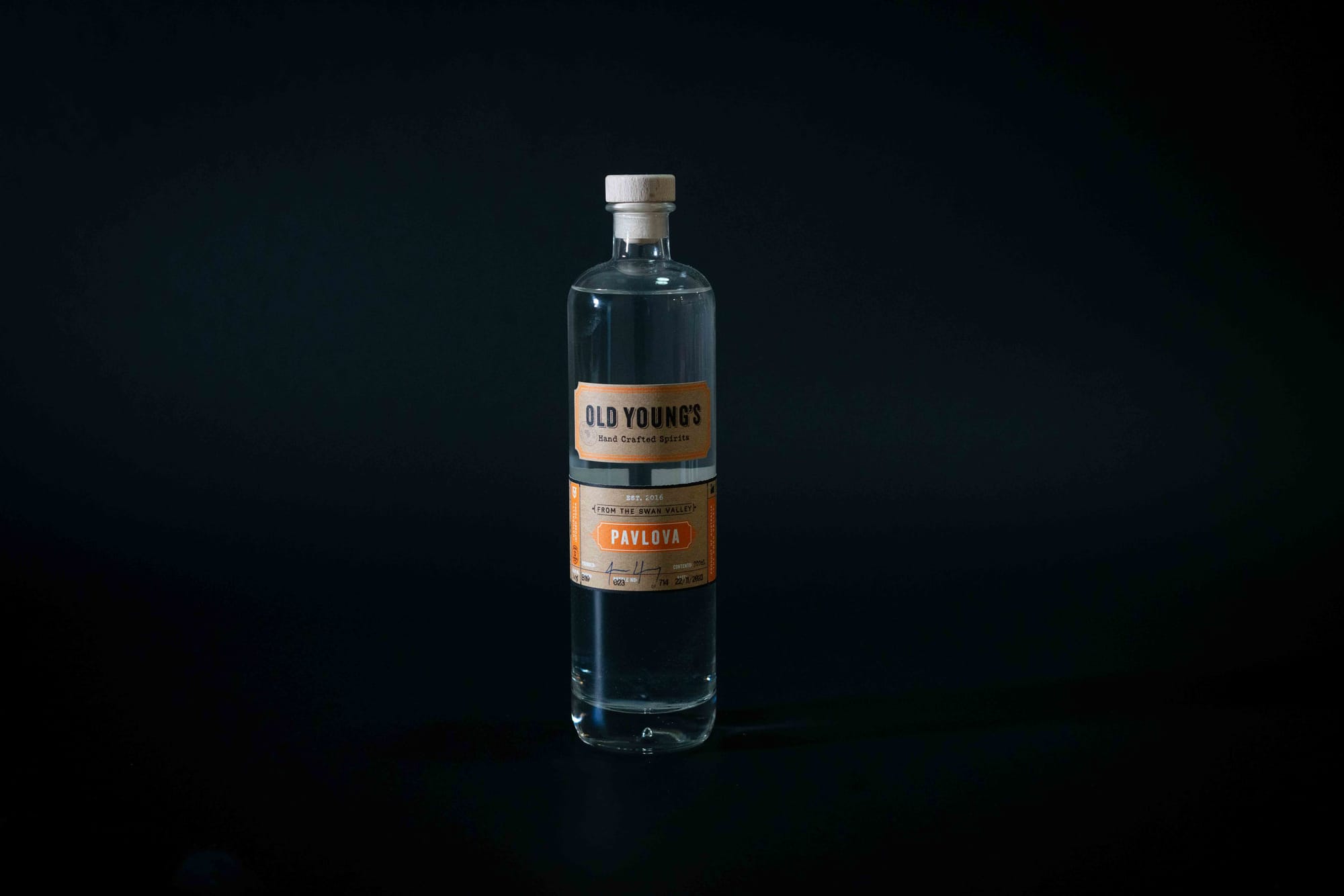
Old Young’s Pavlova Vodka
What they say: With a meringue base and summer fruit infusion, Pavlova is a fitting tribute to the classic dessert that’s as Australian as Phar Lap and Crowded House. Pavlova is sweet, but it’s a sophisticated sweetness.
What we say: The Pav! I’ve tried this in spirits comps a number of times now and I quite like it, so it’s hard to be neutral on it — there are big, lifted aromas of passionfruit and kiwifruit on the nose, some meringue notes too. The palate is dry, full flavoured, with passionfruit, citrus, and a touch of caramel — a generous, long finish.
The Pav, the famous Pav, the world beating Pav, the world’s greatest Pavlova vodka.
Yes, wins that award every year.
Because what I love about this is, I hear about Pavlova vodka and I immediately rolled my eyes until I did taste it and it’s actually very good.
Every bartender says that. My theory has always been if you weren’t dubious, I’d be worried.
Yeah.
Hey, but it’s amazing how quickly bartenders switch. Like the younger ones will sort of go, I don’t know about this. Am I allowed to like it? Is that sort of a thing? But you show it to like an experienced bartender, they’re like, Fuck yeah, that’s delicious — I can make this, this, this, this, and this with it.
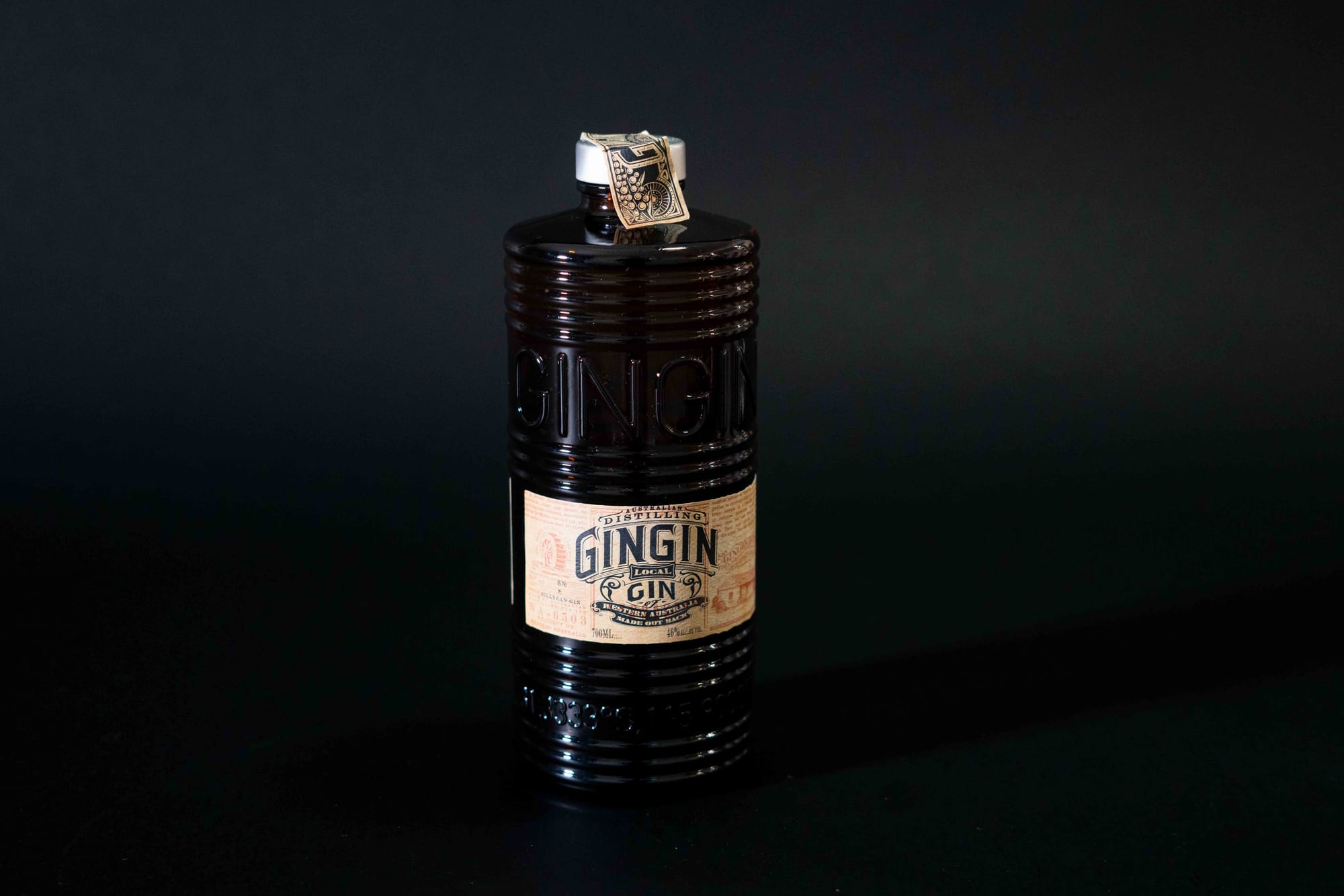
Gingin Gin
What they say: Deep Juniper notes and a citrus finish with a bergamot and elderflower like nose create an elegant and exquisite gin.
What we say: Classic gin aromas up front, juniper to the fore — that character flows through to the palate, it’s big and generous and versatile, with a layered, enjoyable finish.
How do you think about Gingin Gin as a part of the range of gins there? Because it’s in a different bottle.
Yeah, it’s a really — it’s a constant. It’s asking me a really tricky question because it’s a question that like, I think about a lot at the moment, because obviously we did the big crowdfund using Old Young’s as the centerpiece last year. And so it’s Old Young’s that has become the front and center. So now we’re sort of sitting there, we’ve got Old Young’s, where does Gingin Gin fit? And it’s the allrounder in the range. And it’s almost the international gin in the range because it’s 46% ABV. We didn’t set it at 40 to get the excise down or anything like that. We put it up against Botanist and against Monkey 47 and against Gin Mare and all those things. And a lot of those gins are in that sort of 44 to 46 percent ABV range because it’s a fucking gorgeous spot for a gin.
We just said we’re going to make the best gin we humanly possibly can. And it’s kind of a synthesis of the three Old Young’s gins because 1829 is citrus; Six Seasons is savoury; Common Gin, this juniper beast; and Gingin Gin’s all three because it’s got citrus, savoury overtones, and a shit ton of juniper.
It’s the allrounder of the three. And to me, it’s the international play for us as well. I’ve just got to find enough time to do it. But it’s hard in Australia because the excise just means that it’s a $90 gin.
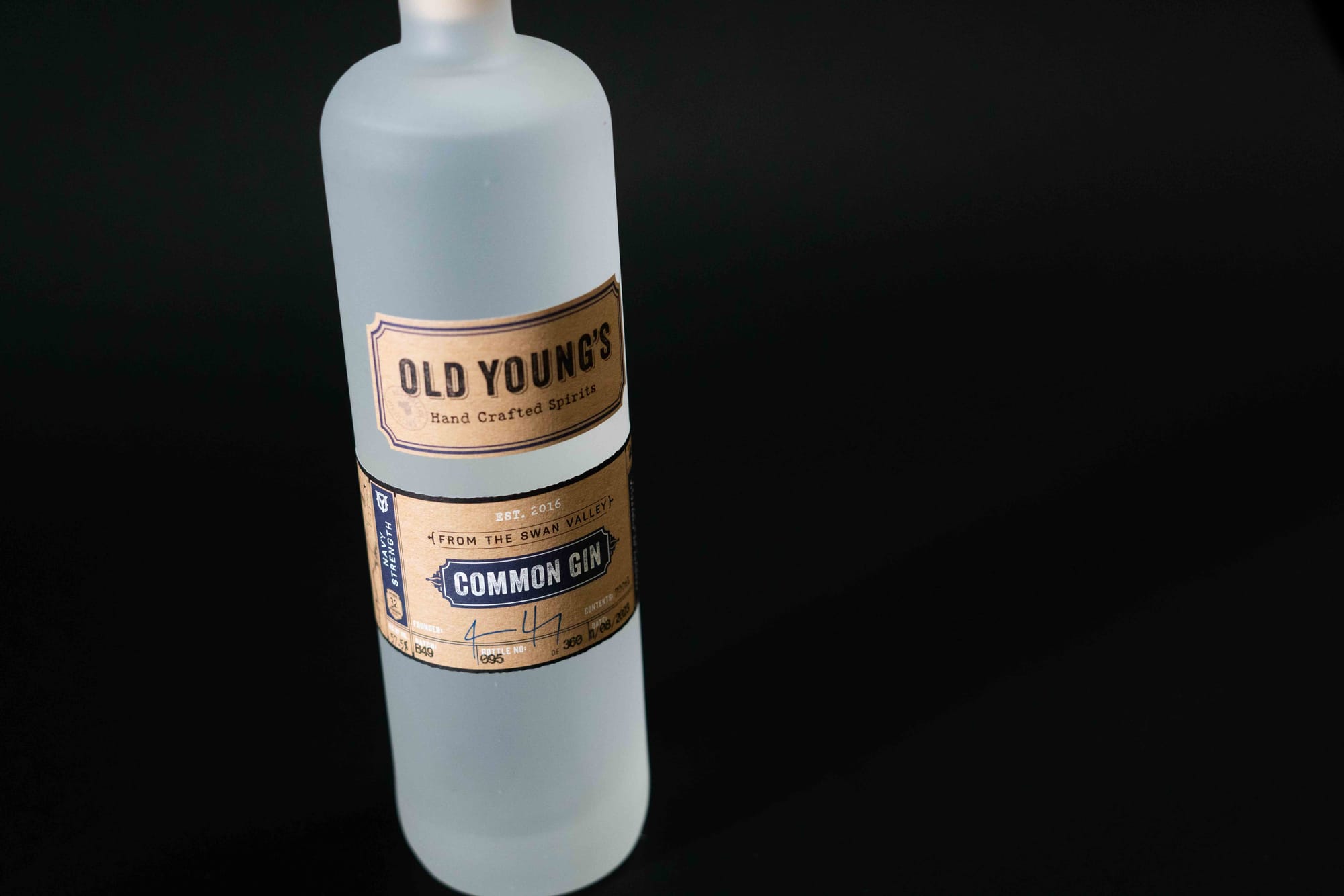
Old Young’s Common Gin
What they say: This navy-strength (57.5%), single botanical (100% juniper) gin, showcases the world’s best Tuscan Juniper that is used in all Old Young’s gins. The juniper leaps out of the glass in all its piney, peppery glory and yet is incredibly smooth for such a high alcohol gin.
What we say: Hits of florals and delicate citrus dance around the juniper forward nose (some lemon zest, perhaps). The palate is appealing, ultra textural, all juniper all the time with notes of florals and lemon, and a long, junipery finish.
With the common gin, that’s the juniper expression. It’s at a navy strength as well, right?
Yeah. That’s the only navy strength, 100 percent juniper gin on the planet.
And it’s a hundred percent juniper.
Yeah, there’s nothing else. There is no where to hide. It’s just the Tuscan juniper.
Yeah, why was it important to make it 100 percent juniper?
Um, well look, cause I’m still to date, to my knowledge, we’re still the only Australian distillers that have Tuscan juniper. So we wanted to show it off. And then it was like, could I make a gin with just juniper that is delicious? It was a really interesting challenge. You’re trying to find those unique points and what can we do that’s different. But it was like, it’s so good — when you taste it and you have it in a Gin & Tonic you go, that’s fucking delicious. And then you go, well, Why the fuck do we even bother with botanicals? This is delicious.
Because you can get different notes out of the juniper, right?
We do. We play a lot of silly buggers with it. We macerate it for 48 hours. We have it in the pot and in a [vapour] basket [in the still]. We do a fair, fair whack with it. Obviously stupendous amounts in the pot. There’s a fair few tricks that we do. [With just juniper] you get that big hit of pine and then you get a bit of a hole [in the mid-palate], and then you can get some a little bit of pepper and stuff at the end. We worked pretty hard to fill that mid-palate hole on just juniper, which should normally be filled by botanicals.
But it just, every time I drink it, it just reminds me like never ever make a gin that’s not full of juniper because it’s delicious.
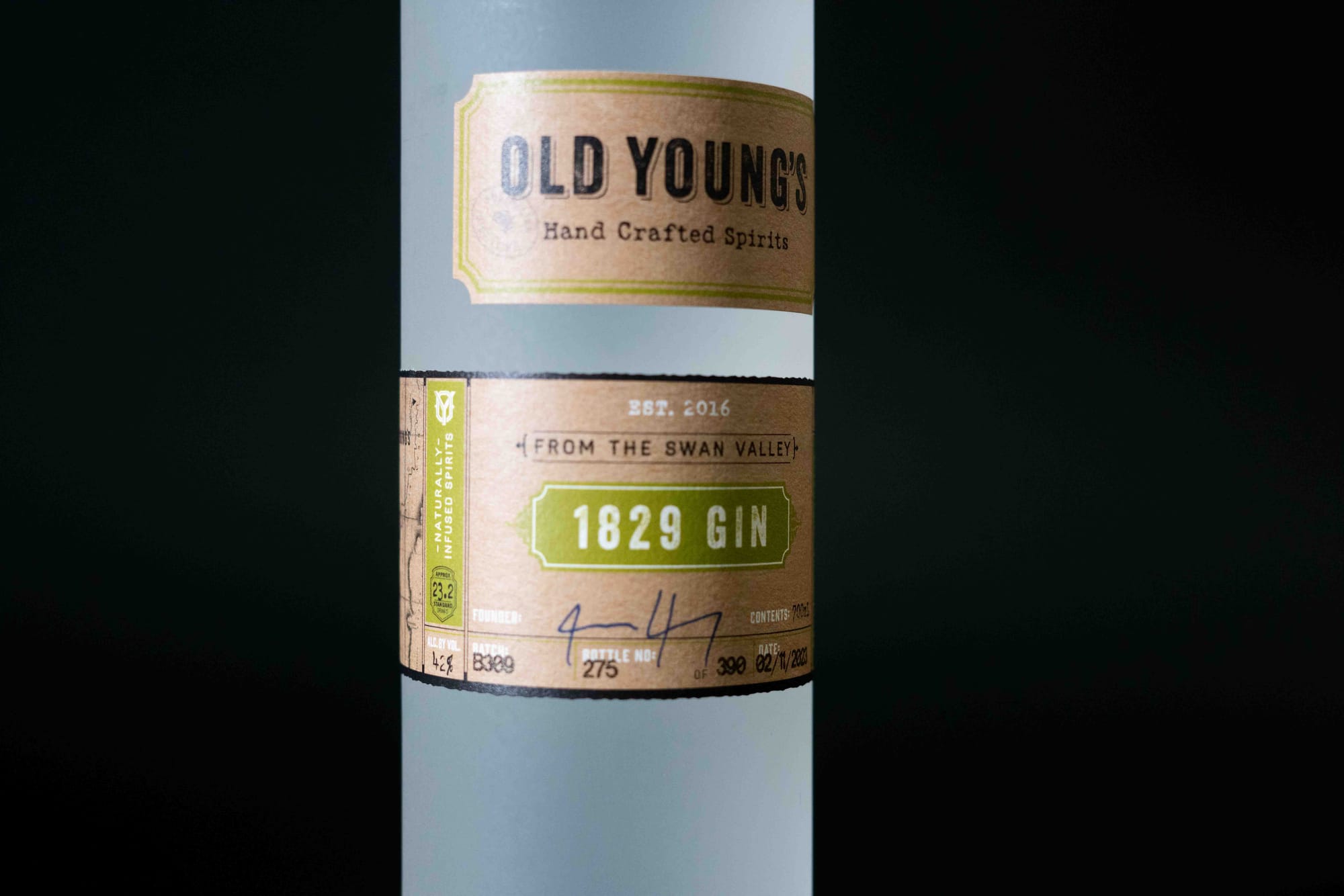
Old Young’s 1829 Gin
What they say: Bright, fresh citrusy. We use our signature Tuscan juniper, add cardamom and native lemon myrtle for aromatics and then turn the citrus level up to 11 with fresh orange and lemon peel.
What we say: A big citrusy nose, with juniper more than present; medium to full bodied on the palate with juniper, citrus (lemony) characters supported by warm hard spices and good length, a peppery, curtsy, junipery finish. Another!
I guess with the 1829, that’s the citrusy one you’re saying. How do you drink that gin?
That’s the crowd pleaser, it’s my desert island gin. For me, that’s my classic Gin & Tonic.
We serve it a lot in the distillery, in the tastery, with grapefruit because it gives people who haven’t been huge gin drinkers that sort of entry level. It’s bright, it’s fresh, it’s citrusy, it’s super approachable. We put it with grapefruit and people are like, fucking happy days.
But for me, I don’t drink it with grapefruit. I drink it in a G&T and I drink it with Indian tonic and I drink it with lime and I keep it super traditional and it just makes me fucking happy because it makes a really great classic — one that I grew up on — Gin & Tonic.
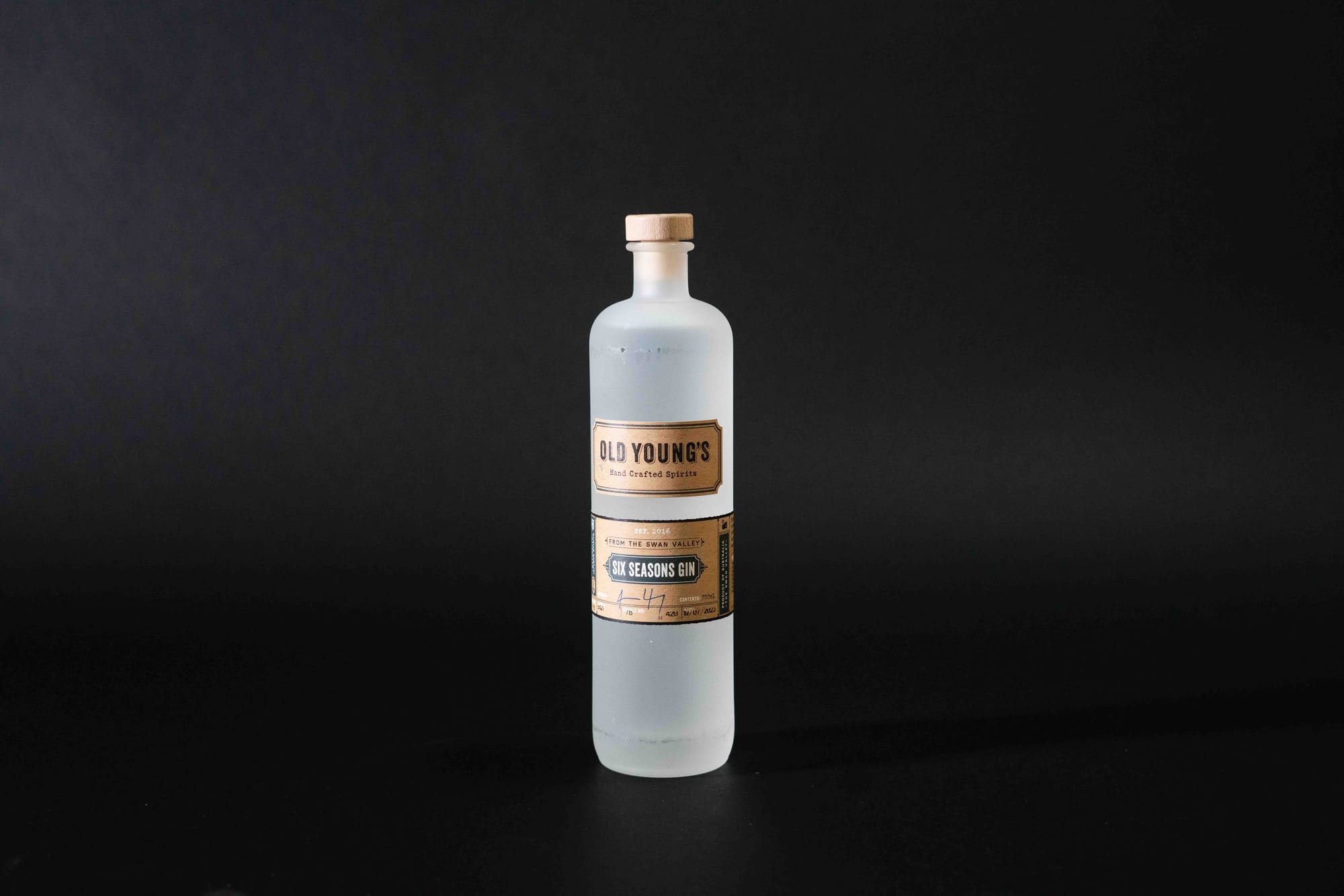
Old Young’s Six Seasons Gin
What they say: A savoury, herbal and complex gin incorporating one native botanical for each of the Six Seasons of the Noongar calendar paired with our Tuscan Juniper. This gin has enormous length and layers of flavour.
What we say: Big Australian gin aromas, but well balanced with juniper, layered, complex. There’s a touch of lemon myrtle, a full generous palate, a great backbone of juniper leading all the way to a citrusy, spicy finish.
Six Seasons is savoury, but that’s a bit more, that’s based around the, Noongar seasons?
Exactly. So it’s basically one botanical per season. The seasons are nice, cold, wet, hot, very hot, extremely hot. It was actually made for a dinner with a chef who does native ingredients, a guy called Paul Iskov from Fervor. And so Yoda (as he is known), and a lady called Dale Tillbrook and I sat down and played with all the different various native botanicals we could get. But I had in my head what we wanted to make, which is a big, bold, savoury gin. And then they talked to me about some of the ingredients that we could use.
We picked those ingredients and then I took them away and turned it into Six Seasons. And then it was so successful at that dinner, it was in our range two weeks later. It was just too delicious not to make.
Want to learn more?
You can read up on Old Young’s at their website, oldyoungs.com.au and follow them on Instagram at @oldyoungsdistillery.


